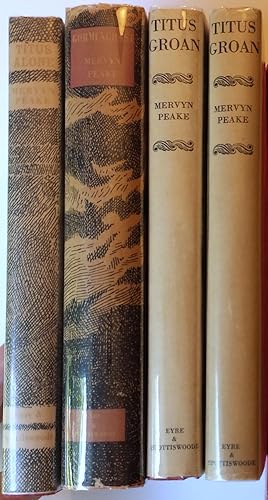
Yet while Tientsin was the China he knew and loved it was his father's descriptions of the fortified Chinese capital of Beijing (he kept a detailed journal of all his travels through China) that formed the basis of the feudalistic society he depicts in the world of Gormenghast. with his eyes fixed excitedly upon the blurred horizon – and the battering of the hoof beats in his ears, Titus rode out of his world. jogged the gray mare to a trot and then into a canter, and finally with a moonlit wilderness before him, to a gallop.

Weaving through the streams of street beggars and traders he would pass temples, pagodas and shacks before finally reaching the colonial building of his British grammar school. Every weekday morning for the next 7 years he would hop down the steps of his family house, climb onto his donkey and trot from the French concession where he lived onto the narrow roads of the city proper. In 1916, at the age of five, Peake moved with his missionary parents from the mountain Chinese resort town of Lushan to the semi-feudal, semi-colonial city of Tientsin.

They sprawled over the sloping earth, each one halfway over its neighbor until, held back by the castle rampart, the innermost of these hovels laid hold on the great walls, clamping themselves there like limpets to a rock. would have displayed a certain ponderous architectural quality were it possible to have ignored the circumfusion of these mean dwellings that swarmed like an epidemic around its outer walls. Like with Mervyn Peake's own experiences as a war artist the madness and death he witnessed shadows his each and every one of his thoughts and actions. While Titus Groan, the trilogy's main character, escapes this stifling existence in the final installment, he can never forget it. Re-imagining the feudalistic China of his youth inside the dark maze like corridors of Gormenghast castle, he creates an atmosphere all ready ripe for the violence and corruption that unfolds in his first two books. If as Aristotle stated "the aim of art is to represent not the outward appearance of things, but their inward significance then Mervyn Peake's illustrated Gormenghast trilogy is one of the 20th century's greatest examples. I want to live! Can't you see? Oh, can't you see? I want to be myself, and become what I make myself, a person, a real live person and not a symbol anymore. (Mervyn's Peake's self portrait) What do I care for the symbolism of it all? What do I care if the castle's heart is sound or not? I don't want to be sound anyway! Anybody can be sound if they're always doing what they're told.

*all pictures by Mervyn Peake unless stated.


 0 kommentar(er)
0 kommentar(er)
